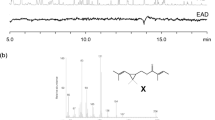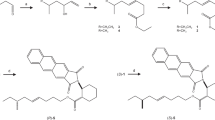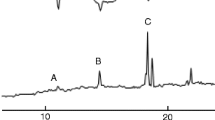Abstract
The chemical composition and functional significance of pheromones of solitary Hymenoptera is much less well known compared to social species. Males of the genus Philanthus (Sphecidae) are territorial and scent mark their territories to attract females. Because of inconsistent results of earlier studies, we reanalyzed the content of the cephalic glands of male European beewolves, Philanthus triangulum F. Besides a variety of alkanes and alkenes, four major compounds were found. Two of these, (Z)-11-eicosen-1-ol and (Z)-10-nonadecen-2-one, had been previously described as constituents of the cephalic glands. We identified 1-octadecanol as a new component of the cephalic gland, and a fourth compound, enantiopure (S)-2,3-dihydrofarnesoic acid, was identified for the first time in nature. Structural elucidation and enantiomeric analysis were performed by HRGC-MS and HRGC-FTIR as well as enantioselective gas chromatography and by means of authentic reference compounds. Occurrence and
Similar content being viewed by others
References
Alcock, J. 1975. Territorial behaviour by males of Philanthus multimaculatus (Hymenoptera: Sphecidae) with a review of territoriality in male sphecids. Anim. Behav. 23:889–895.
Anderbrant, O., Löfquist, J., Högberg, H.-E., Hedenström, E., Baldassari, N., Baronio, P., Kolmakova, G., Lyons, B., Naito, T., Odinokov, V., Simandl, J., Supatashvili, A., Tai, A., and Tourianov, R. 2000. Geographic variation in the field response of male European pine sawflies, Neodiprion sertifer, to different pheromone stereoisomere and esters. Entomol. Exp. Appl. 95:229–239.
Andersen, J. F., Buchmann, S. L., Weisleder, D., Plattner, R. D., and Minckley, R. L. 1988. Identification of thoracic gland constituents from male Xylocopa spp. Latreille (Hymenoptera: Anthophoridae) from Arizona. J. Chem. Ecol. 14:1153–1162.
Arthur, C. L. and Pawliszyn, J. 1990. Solid phase microextraction with thermal desorption using fused silica optical fibers. Anal. Chem. 62:2145–2148.
Attygalle, A. B., Svatos, A., Wilcox, C., and Voerman, S. 1994. Gas-phase infrared spectroscopy for determination of double bond configuration of monounsaturated compounds. Anal. Chem. 66:1696–1703.
Attygalle, A. B., Svatos, A., Wilcox, C., and Voerman, S. 1995. Gas-phase infrared spectroscopy for determination of double-bond configuration of some polyunsaturated pheromones and related compounds. Anal. Chem. 67:1558–1567.
Ayasse, M., Paxton, R. J., and Tengö, J. 2001. Mating behavior and chemical communication in the order Hymenoptera. Annu. Rev. Entomol. 46:31–78.
Bergman, P. and Bergström, G. 1997. Scent marking, scent origin, and species specificity in male premating behavior of two Scandinavian bumblebees. J. Chem. Ecol. 23:1235–1251.
Bergström, G., Kulenberg, B., Ställberg-Stenhagen, S., and Stenhagen, E. 1967. Studies on natural odoriferous compounds. II. Identification of a 2,3–dihydrofarnesol as the main component of the marking perfume of male bumble bees of the species Bombus terrestris L. Ark. Kemi 28:453–469.
Bergström, G. and Svensson, B. G. 1973. 2,3–Dihydro-6, trans-farnesol: Main component in the cephalic marker secretion of Bombus jonellus K. (Hym., Apidae) males. Zoon Suppl. 1:61–65.
Bestmann, H. J., Stransky, W., Vostrowsky, O., and Range, P. 1975. Synthese von 1–substituierten (Z)-9–Alkenen. Chem. Ber. 108:3582–3595.
Bicchi, C., Brunelli, C., Cravotto, G., Rubiolo, P., and Galli, M. 2002. Paper B05, Cd-Rom, in P. Sandra (ed.). Proceedings of the 25rd International Symposium on Capillary Chromatography. I.O.P.M.S., Kortrijk, Belgium.
Borg-Karlson, A.-K. and Tengö, J. 1980. Pyrazines as marking volatiles in philanthine and nyssonine wasps (Hymenoptera: Sphecidae). J. Chem. Ecol. 6:827–835.
Borg-Karlson, A.-K., Tengö, J., Valterová, I., Unelius, C. R., Taghizadeh, T., Tolasch, T., and Francke, W. 2003. (S)-(+)-Linalool, a mate attractant pheromone component in the bee Colletes cunicularius. J. Chem. Ecol. 29:1–14.
Cavill, G. W. K., Davies, N. W., and McDonald, F. J. 1980. Characterization of aggregation factors and associated compounds from the Argentine ant, Iridomyrmex humilis. J. Chem. Ecol. 6:371–384.
Clarke, S. R., Dani, F. R., Jones, G. R., Morgan, E. D., and Schmidt, J. O. 2001. (Z)-3–Hexenyl (R)-3–hydroxybutanoate: A male specific compound in three North American dedorator wasp Eucerceris rubripes, E. conata and E. tricolor. J. Chem. Ecol. 27:1437–1447.
Dunkelblum, E., Tan, S. H., and Silk, P. J. 1985. Double-bond location in monosaturated fatty acids by dimethyl sulfide derivatization and mass spectrometry: Application to analysis of fatty acids in pheromone glands of four Lepidoptera. J. Chem. Ecol. 11:265–277.
Evans, H. E. and O'neill, K. M. 1988. The Natural History and Behavior of North American Beewolves. Cornell University Press, Ithaca, New York.
Free, J. B. 1987. Pheromones of Social Bees. Cornell University Press, Ithaca, New York.
Free, J. B., Ferguson, A. W., and Simpkins, J. R. 1989. Honeybee responses to chemical components from the worker sting apparatus and mandibular glands in the field tests. J. Apic. Res. 28:7–21.
Free, J. B., Ferguson, A. W., Simpkins, J. R., and Al-Sa'ad, B. N. 1983. Effect of honeybee Nasonov and alarm pheromone components on behaviour at the nest entrance. J. Apic. Res. 22:214–223.
Free, J. B., Williams, I. H., Pickett, J. A., Ferguson, A. W., and Martin, A. P. 1982. Attractiveness of (Z)-11–eicosen-1–ol to foraging honeybees. J. Apic. Res. 21:151–156.
Gnanasunderam, C., Young, H., and Hutchins, R. 1985. Defensive secretions of the New Zealand tenebrionids: V. Presence of methyl ketones in Uloma tenebrionoides (Coleoptera: Tenebrionidae). J. Chem. Ecol. 11:465–472.
Gwynne, D. T. 1978. Male territoriality in the bumblebee wolf, Philanthus bicinctus (Mickel) (Hymenoptera, Sphecidae): Observations on the behaviour of individual males. Z. Tierpsychol. 47:89–103.
Hansson, B. S., Tóth, M., Löfstedt, C., Szöcs, G., Subchev, M., and Löfqvist, J. 1990. Pheromone variation among Eastern European and a Western Asian population of the turnip moth Agrotis segetum. J. Chem. Ecol. 16:1611–1622.
Ho, H.-Y. and Millar, J. G. 2001a. Identification and synthesis of a male-produced sex pheromone from the stink bug Chlorochroa sayi. J. Chem. Ecol. 27:1177–1201.
Ho, H.-Y. and Millar, J. G. 2001b. Identification and synthesis of male-produced sex pheromone components of the stink bugs Chlorochroa ligata and Chlorochroa uhleri. J. Chem. Ecol. 27:2067–2095.
Kawazu, K., Hasegawa, J.-I., Honda, H., Ishikawa, Y., Wakamura, S., Sugie, H., Kamiwada, H., Kamimuro, T., Yoshiyasu, Y., and Tatsuki, S. 2000. Geographical variation in female sex pheromones of the rice leaffolder moth, Cnaphalocrocis medinalis: Identification of pheromone components in Japan. Entomol. Exp. Appl. 96:103–109.
Löfstedt, C., Löfqvist, J., Lanne, B. S., Van der Pers, J. N. C., and Hansson, B. S. 1986. Pheromone dialects in European turnip moths Agrotis segetum. Oikos 46:250–257
McDaniel, C. A., Howard, R. W., O'neill, K. M., and Schmidt, J. O. 1987. Chemistry of male mandibular gland secretions of Philanthus basilaris Cresson and Philanthus bicinctus (Mickel) (Hymnoptera: Sphecidae). J. Chem. Ecol. 13:227–235.
McDaniel, C. A., Schmidt, J. O., and Howard, R. W. 1992. Mandibular gland secretions of the male beewolves Philanthus crabroniformis, P. barbatus, and P. pulcher (Hymenoptera: Sphecidae). J. Chem. Ecol. 18:27–37.
O'neill, K. M. 1979. Territorial behavior in males of Philanthus psyche (Hymenoptera, Sphecidae). Psyche 86:19–43.
O'neill, K. M. 1983. Territoriality, body size, and spacing in males of the beewolf Philanthus basilaris (Hymenoptera; Sphecidae). Behaviour 86:295–321.
Pickett, J. A., Williams, I. H., and Martin, A. P. 1982. (Z)-11–Eicosen-1–ol, an important new pheromonal component from the sting of the honey bee, Apis mellifera L. (Hymenoptera, Apidae). J. Chem. Ecol. 8:163–175.
Schmidt, J. O., McDaniel, C. A., and Simon Thomas, R. T. 1990. Chemistry of male mandibular gland secretions of Philanthus triangulum. J. Chem. Ecol. 16:2135–2143.
Schmidt, J. O., Morgan, E. D., Oldham, N. J., Do Nascimento, R. R., and Dani, F. R. 1997. (Z)-11–Eicosenol, a major component of Apis cerana venom. J. Chem. Ecol. 23:1929–1339.
Schmidt, J. O., O'neill, K. M., Fales, H. M., McDaniel, C. A., and Howard, R. W. 1985. Volatiles from mandibular glands of male beewolves (Hymenoptera: Specidae, Philanthus) and their possible roles. J. Chem. Ecol. 11:895–901.
Simon Thomas, R. T. and Poorter, E. P. R. 1972. Notes on the behaviour of males of Philanthus triangulum (F.) (Hymenoptera, Sphecidae) Tijdschr. Entomology 115:141–151.
Snyder, J. C., Guo, Z., Thacker, R., Goodman, J. P., and Pyrek, J. S. 1993. 2,3–Dihydrofarnesoic acid, a unique terpene from trichomes of Lycopersicon hirsutum repels spider mites. J. Chem. Ecol. 19:2981–2997.
Strohm, E., Laurien-Kehnen, C., and Bordon, S. 2001. Escape from parasitism: Spatial and temporal strategies of a sphecid wasp against a specialised cuckoo wasp. Oecologia 129:50–57.
Strohm, E. and Lechner, K. 2000. Male size does not affect territorial behaviour and life history traits in a sphecid wasp. Anim. Behav. 59:183–191.
Strohm, E. and Linsenmair, K. E. 1997a. Female size affects provisioning and sex allocation in a digger wasp. Anim. Behav. 54:23–34.
Strohm, E. and Linsenmair, K. E. 1997b. Low resource availability causes extremly male-biased investment ratios in the European beewolf, Philanthus triangulum F. (Hymenoptera, Sphecidae). Proc. R. Soc. Lond. B 264:423–429.
Svensson, B. G. and Bergström, G. 1977. Volatile marking secretions from the labial gland of North European Pyrobombus D. T. males (Hymenoptera, Apidae). Insect. Soc. 24:213–224.
Svensson, B. G. and Bergström, G. 1979. Marking pheromones of Alpinobombus males. J. Chem. Ecol. 5:603–615.
Thornhill, R. and Alcock, J. 1983. The Evolution of Insect Mating Systems. Harvard University Press, Cambridge, Massachusetts.
Tóth, M., Talekar, N. S., and Szöcs, G. 1996. Optimization of blends of synthetic pheromone components for trapping limabean pod borers (Etiella zinckenella Tr.) (Lepidoptera: Phycitidae): Preliminary evidence on geographical differences. Bioorg. Med. Chem. 4:495–497.
Vander Meer, R. K., Breed, M. D., Espelie, K. E., and Winston, M. L. 1998. Pheromone Communication in Social Insects. Westview Press, Boulder, Colorado.
Yatsynin, V. G., Rubanova, E. V., and Okhrimenko, N. V. 1996. Identification of female-produced sex pheromones and their geographical differences in pheromone gland composition from click beetles (Col., Elateridae). J. Appl. Entomol. 120:463–466.
Author information
Authors and Affiliations
Corresponding author
Rights and permissions
About this article
Cite this article
Schmitt, T., Strohm, E., Herzner, G. et al. (S)-2,3-Dihydrofarnesoic Acid, a New Component in Cephalic Glands of Male European Beewolves Philanthus triangulum . J Chem Ecol 29, 2469–2479 (2003). https://doi.org/10.1023/A:1026305901049
Issue Date:
DOI: https://doi.org/10.1023/A:1026305901049




